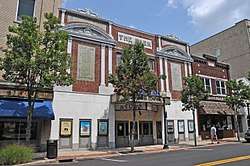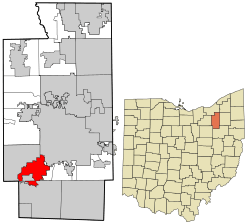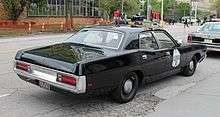Barberton, Ohio
Barberton is a city in Summit County, Ohio, United States. The population was 26,550 at the 2010 census. It is adjacent to Akron and is part of the Akron metropolitan area.
Barberton, Ohio | |
|---|---|
 Buildings in downtown Barberton, 2008 | |
| Nickname(s): The Magic City | |
 Location in Summit County and the state of Ohio. | |
 Barberton Location in Ohio  Barberton Barberton (the United States)  Barberton Barberton (North America) | |
| Coordinates: 41°0′57″N 81°36′21″W | |
| Country | United States |
| State | Ohio |
| County | Summit |
| Government | |
| • Mayor | William Judge (D)[1] |
| Area | |
| • Total | 9.24 sq mi (23.93 km2) |
| • Land | 9.02 sq mi (23.35 km2) |
| • Water | 0.22 sq mi (0.57 km2) |
| Elevation | 974 ft (297 m) |
| Population | |
| • Total | 26,550 |
| • Estimate (2019)[5] | 25,953 |
| • Density | 2,878.23/sq mi (1,111.33/km2) |
| Time zone | UTC-5 (Eastern (EST)) |
| • Summer (DST) | UTC-4 (EDT) |
| ZIP code | 44203 |
| Area code(s) | 330, 234 |
| FIPS code | 39-03828[6] |
| GNIS feature ID | 1037625[3] |
| Website | https://www.cityofbarberton.com/ |
History
Barberton was founded in 1891 by industrialist Ohio Columbus Barber, who planned the town according to his vision of industry, progress and community. In 1894 he moved the manufacturing operations of the Diamond Match Company, which he formed from a merger of 11 companies, from Akron to Barberton. He soon was producing 250 million matches a day.[7] In the valley running parallel to the Tuscarawas River and the Ohio & Erie Canal, he oversaw the construction of factories, residential neighborhoods and a compact commercial downtown. In the center of the new city was Lake Anna, named after Barber's only daughter, Anna Laura Barber.
Barberton became known as the "Magic City" because of its rapid population growth during its formative industrial years, at a time of waves of immigration from eastern and southern Europe. In 1891, when Barberton was incorporated, the scattered farms that had originally characterized the landscape were transformed into a fledgling city of 1,800. When an Akron Beacon Journal reporter revisited Barberton in 1893, he noted that since 1891, it had grown so quickly that it appeared to have grown by magic (hence its nickname). Many new immigrants were attracted to its industrial jobs, which provided a path to assimilation.

In 1908 on a high hill on the east side of town, Barber began construction of an experimental farm and estate, which he called Anna Dean Farm. It included his 52-room, French Renaissance Revival-style mansion, completed in 1909, and lush gardens, dozens of barns and other structures in the same style, and greenhouses. Barber built 35 structures for the Anna Dean Farm, all in the French Renaissance Revival style. The farm covered 3500 acres. Believing farming could be as efficient as industry, Barber intended the farm to be the basis of an agricultural college, but he did not complete its financing before his death. He willed the farm to Western Reserve University (now Case Western Reserve University). It later sold much of the property.[8]
Today, five of the eight primary buildings and associated property of the farm complex are owned by the Barberton Historical Society. These buildings are constructed of red brick edged in white concrete block, with royal blue trim and red tile roofing. The most significant of the remaining buildings is Barn No. 1, the former Dairy Barn, restored in 1985 and now the world headquarters of the Yoder Brothers Corporation, horticulturists. The building has castle tower-like silos, visible from much of the east side of the city. The other barns have been structurally stabilized and at least partially restored. All but one may be renovated for other economic uses. The Creamery has been restored as a residence for the same family since 1943, and served as the birthplace for the Apostolic Church of Barberton founded in 1950.[8]

After sale by Western Reserve University following World War II, most of the 40-acre Barber estate was broken up and redeveloped for suburban residential housing. The mansion was demolished in 1965.
"The Magics" became the mascot name of the Barberton High School athletic teams. As Barberton High School colors are purple and white, "purple pride" marks local enthusiasm for the school. The city's schools have also improved academic performance since the 1980s.
Barberton's sources of news include daily newspapers from major cities, such as the Akron Beacon Journal and the Cleveland Plain Dealer, as well as the local weekly newspaper, the Barberton Herald.
During the 1980s Barberton suffered a precipitous economic decline due to restructuring in heavy industry and job losses, similar to much of the rest of the industrial American Midwest. It was in many ways representative of a typical Rust Belt city. During this period, the city lost a large part of its economic base as factories shuttered and stores went vacant. The Magic City: Unemployment in a Working-Class Community (Cornell University Press, 1989) documents the consequences of the migration of major industry from the region and the responses of residents to such dramatic changes.
In 1985, key business stakeholders and government leaders created the Barberton Community Development Corporation (BCDC). The BCDC today functions through a Board of Directors of 20 stakeholders and city members, including the Mayor of Barberton. Led by Tom Anders as Chairman, and Executive Director Larry Lallo, it has facilitated the creation of over 2000 jobs, and in excess of $100 million in business expansion projects. They have stimulated the creation of three mini-industrial parks, and 25 new construction projects. The BCDC was originally funded through federal funds, and donations of real estate by the Babcock & Wilcox Company. With the creation of the Barberton Community Foundation in the late 1990s, the BCDC entered into a new level. It invested a portion of the Foundation's assets in prime credit business expansion projects.
The Barberton Community Foundation facilitated the construction of a new Barberton High School, located on reclaimed swampland in the northwest section of the city.
Geography
According to the 2010 census, the city has a total area of 9.26 square miles (24.0 km2), of which 9.04 square miles (23.4 km2) (or 97.62%) is land and 0.22 square miles (0.57 km2) (or 2.38%) is water.[9][10]
Lake Anna, a glacial kettle lake, is a 1-acre (4,000 m2) natural spring lake that lies in the center of the original village of Barberton. It is the center of a 21-acre (85,000 m2) park named after it. Lake Anna is named for O. C. Barber's daughter Anna Laura Barber.
Demographics
| Historical population | |||
|---|---|---|---|
| Census | Pop. | %± | |
| 1900 | 4,354 | — | |
| 1910 | 9,410 | 116.1% | |
| 1920 | 18,811 | 99.9% | |
| 1930 | 23,934 | 27.2% | |
| 1940 | 24,028 | 0.4% | |
| 1950 | 27,820 | 15.8% | |
| 1960 | 33,805 | 21.5% | |
| 1970 | 33,052 | −2.2% | |
| 1980 | 29,732 | −10.0% | |
| 1990 | 27,623 | −7.1% | |
| 2000 | 27,899 | 1.0% | |
| 2010 | 26,550 | −4.8% | |
| Est. 2019 | 25,953 | [5] | −2.2% |
| Sources:[6][11][12] | |||
2010 census
At the 2010 census there were 26,550 people in 11,054 households, including 6,880 families, in the city. The population density was 2,936.9 inhabitants per square mile (1,133.9/km2). There were 12,191 housing units at an average density of 1,348.6 per square mile (520.7/km2). The racial makup of the city was 90.8% White, 5.9% African American, 0.3% Native American, 0.3% Asian, 0.4% from other races, and 2.2% from two or more races. Hispanic or Latino of any race were 1.4%.[4]
There were 11,054 households, of which 30.1% had children under age 18 living with them, 39.9% were married couples living together, 16.3% had a female householder with no husband present, 6.0% had a male householder with no wife present, and 37.8% were non-families. 32.2% of households were one person and 13.8% were one person aged 65 or older. The average household size was 2.37 and the average family size was 2.97.
The median age was 39.8 years. 23.5% of residents were under the age of 18; 8.2% were between the ages of 18 and 24; 24.8% were from 25 to 44; 27.1% were from 45 to 64; and 16.5% were 65 or older. The gender makeup of the city was 47.9% male and 52.1% female.
2000 census
At the 2000 census there were 27,899 people in 11,523 households, including 7,443 families, in the city. The population density was 3,095.2 people per square mile (1,195.5/km2). There were 12,163 housing units at an average density of 1,349.4 per square mile (521.2/km2). The racial makup of the city was 92.43% White, 5.33% African American, 0.27% Native American, 0.37% Asian, 0.01% Pacific Islander, 0.24% from other races, and 1.36% from two or more races. Hispanic or Latino of any race were 0.64%.[6]
There were 11,523 households, of which 29.5% had children under age 18 living with them, 44.9% were married couples living together, 15.4% had a female householder with no husband present, and 35.4% were non-families. 30.1% of households were one person and 14.0% were one person aged 65 or older. The average household size was 2.39 and the average family size was 2.96.
The age distribution was 24.8% under the age of 18, 8.4% from 18 to 24, 28.3% from 25 to 44, 21.2% from 45 to 64, and 17.3% 65 or older. The median age was 37 years. For every 100 females, there were 87.5 males. For every 100 females age 18 and over, there were 82.8 males.
The median household income was $32,178 and the median family income was $39,387. Males had a median income of $32,294 versus $21,778 for females. The per capita income for the city was $17,764. About 11.5% of families and 13.3% of the population were below the poverty line, including 21.3% of those under age 18 and 7.5% of those age 65 or over.
Notable people
- John Cominsky, professional football player in the National Football League (NFL)
- Glenn Davis, Olympic runner and gold medalist; professional football player in the NFL
- Derrick Dukes, professional wrestler in the American Wrestling Association
- David M. Kelley, founder of IDEO
- Josh McDaniels, football coach in the NFL
- George Morgan, country music singer
- Hal Naragon, professional baseball player in Major League Baseball
- Alvin Robertson, professional basketball player in the National Basketball Association (NBA)
- Bo Schembechler, college football coach
- Lynn St. John, Athletic Director for The Ohio State University
- Betty Sutton, politician in the Democratic Party
- Jeff Tabaka, professional baseball player in Major League Baseball
- Joe Williams, professional football player in the NFL
- Howard E. Woodford, Medal of Honor recipient
See also
- Barberton chicken
- Erie Depot (Barberton, Ohio)
References
- "For Barberton mayor: William Judge in the Democratic primary". Ohio.com. 25 August 2015. Retrieved 1 February 2016.
- "2019 U.S. Gazetteer Files". United States Census Bureau. Retrieved July 27, 2020.
- "US Board on Geographic Names". United States Geological Survey. 2007-10-25. Retrieved 2008-01-31.
- "U.S. Census website". United States Census Bureau. Retrieved 2013-01-06.
- "Population and Housing Unit Estimates". Retrieved May 21, 2020.
- "U.S. Census website". United States Census Bureau. Retrieved 2008-01-31.
- "Barberton", Ohio History Central
- Bob Bissler, "Saving the Farm", Akron Magazine, Fall 2001, hosted by permission on Anna Dean Farm Website, accessed 25 Sep 2010
- "2010 Census U.S. Gazetteer Files for Places – Ohio". United States Census. Archived from the original on 2016-07-02. Retrieved 2012-10-19.
- "US Gazetteer files: 2010, 2000, and 1990". United States Census Bureau. 2011-02-12. Retrieved 2011-04-23.
- "Number of Inhabitants: Ohio" (PDF). 18th Census of the United States. U.S. Census Bureau. 1960. Retrieved 24 April 2020.
- "Ohio: Population and Housing Unit Counts" (PDF). U.S. Census Bureau. Retrieved 22 November 2013.
